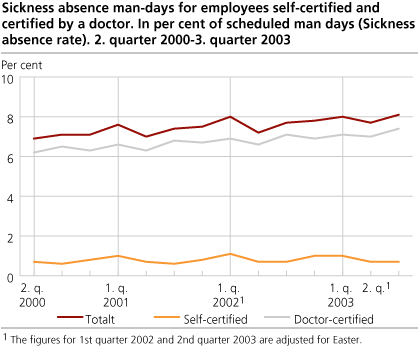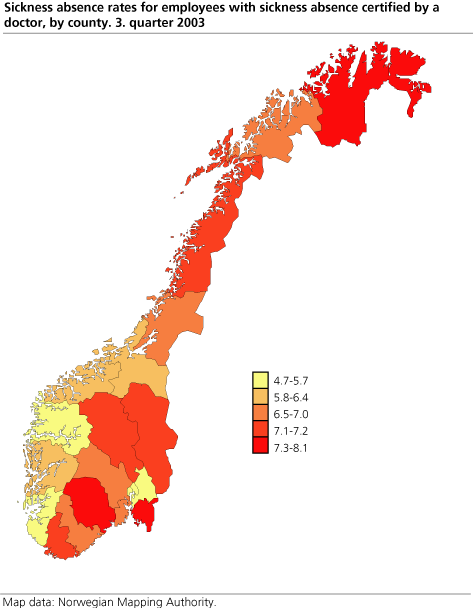Content
Published:
This is an archived release.
Continued increase in sickness absence
The sickness absence rate increased from 7.7 to 8.1 per cent from the third quarter 2002 to the corresponding quarter 2003. There was no increase in self-certified absence, but absence certified by a doctor increased by 0.4 percentage points.
The absence rate increased from 9.3 to 9.7 for women and from 6.5 to 6.9 for men.
Lowest growth in education and manufacturing
Sickness absence showed no change in education from the third quarter last year. Manufacturing, mining and electricity and water supply increased by 0.1 percentage points. The increase was particularly low for women in manufacturing.
Highest increase in construction
Sickness absence increased by 0.9 percentage points in construction and 0.8 percentage points in transport and communication. The average increase was 0.4.
Rise in long-term absence
Sickness absence lasting longer than six months increased its share of the total absence.
The following comments are based on figures for sickness absence certified by a doctor, which represents approximately 90 per cent of the total absence. The survey on self-certified absence does not include the variables age or county of residence.
Highest increase among men in their 50s
For men, sickness absence certified by a doctor saw the highest increase in the age group 50-59. For women the increase is highest in the age group 25-34. Women in this group also had a very high sickness absence rate at 9.0 per cent for women aged 25-29 and 9.6 for women aged 30-34. A part of this absence is due to sickness related to pregnancy.
Low increase in Oslo
Oslo had the lowest increase at 0.1 percentage points compared with the third quarter last year.
Nord-Trøndelag had the highest increase at 0.9 percentage points.
Sickness absence statistics in Statbank Norway
StatBank Norway is an Internet service containing detailed statistics on sickness absence by sex, age, industry and county of residence.
Tables:
- Table 1 Sickness absence man-days for employees self-certified and certified by a doctor. In per cent of scheduled man-days (sickness absence rate). Quarterly figures. 2000-2003
- Table 2 Sickness absence man-days for employees self-certified and certified by a doctor, by sex. In per cent of scheduled man-days (Sickness absence rate). Quarterly figures. 2000-2003
- Table 3 Sickness absence man-days for employees self-certified and certified by a doctor, by industry and type of sickness absence. In per cent of scheduled man days (sickness absence rate). Quarterly figures. 2000-2003
Contact
-
Arbeidsmarked og lønn
E-mail: arbeidsmarked@ssb.no
-
Unn H. Høydahl
E-mail: unnh.hoydahl@ssb.no
tel.: (+47) 40 90 23 77


